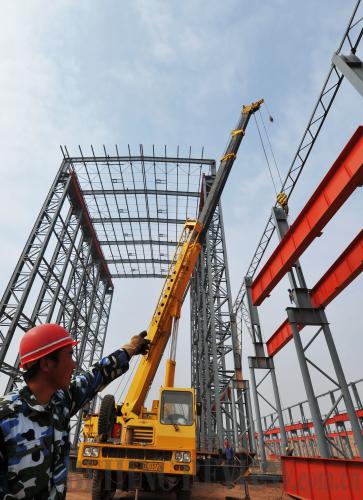|
 |
|
RARE EARTH BOOM: Construction of a rare earth steel plate project is under way in Zhongning County, Ningxia Hui Autonomous Region. With an investment of 8.7 billion yuan ($1.3 billion), the project is part of the country's efforts to invigorate and streamline the rare earth industry (LIU QUANLONG) |
With demands for rare earth surging in the 1990s, thousands of mines sprouted up across the country, engaging in reckless mining and illicit production. As small companies vied for export deals, the valuable minerals were sold at amazingly low prices. In 2009, China's rare earth export increased 16.67 percent from the year before, but the value dropped 34.92 percent, according to MOFCOM data.
"As an effort to reorganize the crowded industry, the government will set tougher standards for companies in terms of energy efficiency and emissions," said the State Council, in the circular.
"The rules are likely to drive nearly 90 percent of smaller companies out of the market," said Zong Zijiu, a professor with ENFI. "The government will likely allow another two or three years for them to improve their techniques. Those who cannot meet the requirements will be forced to shut down."
In another move, policymakers will encourage mergers and acquisition in the sector and sharply reduce the number of miners and smelters, said the circular.
The short-term goal is to allow top three producers to control 80 percent of the ion-adsorbed rare earth industry in south China, it added.
In northern regions, the Inner Mongolia Baotou Steel Rare Earth Hi-Tech Co. Ltd. has gained market monopoly, with its output accounting for 40 percent of the nation's total. In the latest attempt to extend its reach, the company in April acquired a 66.7-percent stake in the Baotou Huamei Rare-Earth High-Tech Co. Ltd., China's largest manufacturer of rare earth carbonates.
The southern markets, however, are more fragmented, with several companies competing for a dominant position.
Centrally administered state-owned companies like China Minmetals Corp. and Aluminum Corp. of China Ltd. are making a push into the market of south Jiangxi Province, which controls 70 percent of the country's ion-adsorbed rare earth deposits.
"The behemoths glitter with advanced smelting and processing techniques, but their forays are hindered by limited access to resources," said Yuan Zhibin, a researcher with the Shenzhen-based research institute CIConsulting. "The local player Ganzhou Rare Earth Mineral Industry Co. Ltd., supported by the local government, has monopolized the resources."
With rare earth prices creeping up, local governments and private players may resist consolidation and protect local deposits that are now viewed as more profitable, said Sang Yongliang, an analyst with the Guotai Jun'an Securities Co. Ltd.
"To solve the dilemma, policymakers need to find ways to strike a balance between central and local interests," he said.
The road ahead
The government-precipitated industry restructuring is forcing up rare earth prices. From January to April, average prices of 17 elements have almost doubled as demands boomed and supplies tightened, according to data from Cre.net, a major rare earth information site.
In February, prices of China's rare earth for export averaged $109,036 a ton, skyrocketing nine fold from a year ago, said the General Administration of Customs.
"As rare earths are integral to a number of hi-tech products, demands for such strategic minerals are bound to shoot up," said Li Junfeng, Deputy Director of the Energy Research Institute under the National Development and Reform Commission. "Meanwhile, unscrupulous speculators are hoarding the minerals, blowing up a price bubble."
The price inflation brought windfall profits to miners, but for downstream processors, it came as a deadly blow.
"We are struggling to make ends meet due to the severe costs inflation," said Tang Yinxuan, Chairman of Daming Fluorescent Material Co. Ltd., a Hangzhou-based manufacturer of fluorescent from rare earths. "We are less able to pass the increased costs on to customers due to fierce competition. More disturbing, though, is the fact that upstream producers have cut back on supplies of raw materials, expecting to capitalize on price surges."
In response, the government is determined to strengthen supervision over the sector and strike hard against speculation, said Dou Xuehong, a senior researcher at the Baotou Research Institute of Rare Earth.
Looking ahead, the international investment bank Goldman Sachs predicted that the price boom is nearing its end, as Western companies start up new mines to compete with Chinese firms.
"The supply deficit will peak this year before the market slips into a slight surplus in 2013. The prices will likely continue to rise initially, but may moderate by 2015," said Malcolm Southwood, an analyst with Goldman Sachs.
The U.S. company Molycorp. Minerals LLC. recently reopened a mine that was closed in 2002, and is expected to produce 20,000 tons of rare earth annually.
Meanwhile, the Australian miner Lynas Corp. is in the process of building a rare earth refinery in Malaysia and plans to develop new deposits in the southeast African country Malawi. In addition, state-run Japan Oil, Gas and Metals National Corp. in February 2011 joined hands with a company in Uzbekistan to explore a rare earth mine in the Central Asian nation. | 